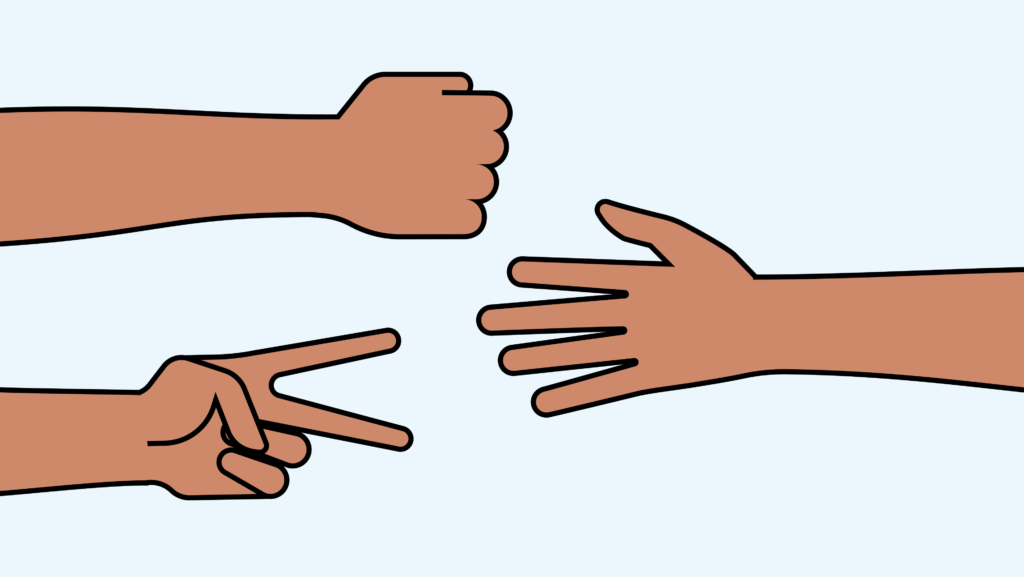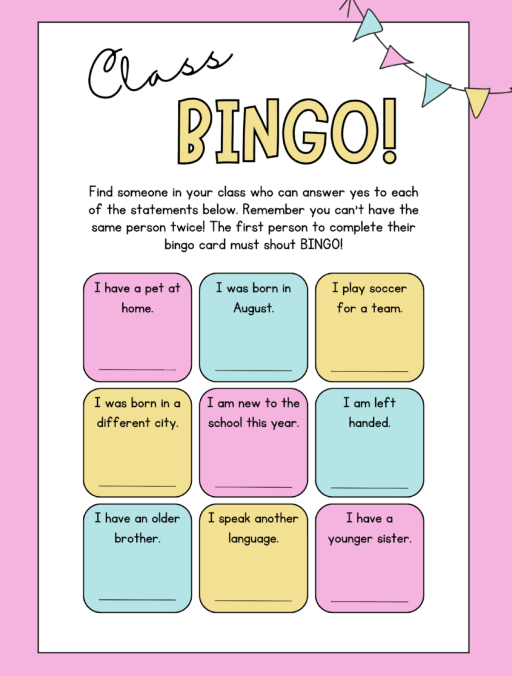15 First week of school activities for students
In this guide
The first week of school is full of a range of emotions for students, teachers and parents alike. There is an interesting mixture of excitement and ambiguity that creates an energy unlike any other time of the year. It is a really special time where relationships are formed and experiences exist without the direct pressure of grades.
That first week can be an incredible opportunity to begin developing the culture for your classes. The pressure to jump straight into curriculum can be overwhelming but resisting that urge can pay dividends in the long run.
Tradition seems to dictate that you should go over your syllabus during the first week of school but this is probably one of those cases where we should ignore tradition. No student (or teacher that I know) finds a syllabus engaging so it seems like the wrong way to kick off a new year. Just because you do not specifically address your syllabus does not mean that the first week has to avoid classroom norms and expectations. The right activity can help students feel, see, and understand what your class will be all about instead of just hearing it or reading.
No matter what subject I am teaching I focus on community, collaboration, and creativity in the activities I use during the first week so that students learn from the start what is most important in our learning environment.
People will forget what you said, people will forget what you did, but people will never forget how you made them feel.
Maya Angelou
Use the first week of school to provide meaningful experiences that make students feel safe and comfortable while also introducing key expectations that will guide student mindsets as they approach the upcoming learning journey.
First week activities for elementary students

1) Classroom scavenger hunt
Partner students up to go on a classroom scavenger hunt. Be strategic with the items the students will look for (the classroom library, the pencil sharpener, hall pass, etc.) This is a great way to get students familiar with the space as well as get to know another student in class.
This activity helps get students more comfortable in a new space as well as developing a sense of autonomy so that they do not constantly need your assistance with every task during the day. With older students it can be helpful to include rules or directions for each item so that they can learn about important guidelines without a lecture or direct instruction.
2) Setting up classroom norms
Start with a poster/circle map titled Classroom Rules. There should be no other writing on the poster. Have students think, pair, share some classroom rules that are important to them. Write all the rules down as the students share. This activity allows for students to take ownership over their classroom expectations.
Students will come up with many valuable rules that first day, but be sure to add to the poster as the week and year continue. Other important rules will come up.
Extension: Students can work together to categorize the rules into categories such as rules that allow us to be: safe, responsible, respectful. It is helpful to reference the poster throughout the year to remind the students of the rules that were important to them. “I see on our poster that you all shared with me that walking into the classroom quietly was important to you. Let’s be sure to work on that because it helps us show respect at school.”
3) Successful student activity
The successful student activity is a great opportunity for students to think about what skills/qualities they need to be successful. The class should start with a discussion about what a successful student looks like (focused, on topic, responsible, organized, kind, respectful, etc.) It can help to ask what a successful student looks like, sounds like, thinks like. Students can then show their own understanding of a successful student by drawing a picture of themselves and adding the words around the picture. Another option is to print out a photo of the student and then have the student add the words around the photo. As a bonus, this is a great artifact for Back to School Night or Open House.
Extension: Have students share ideas of what a successful teacher looks like, sounds like, and thinks like. This is a great reminder for all of us about the needs and wants of students as we start the year.
4) Classmate bingo
Hand out the same bingo card to all of your students. This bingo card should have squares on it that say things like: has been to the beach, has a dog, does not have a brother, has 4 letters in their name, etc. Have students find another student that fits the description in one box. They will then write that child’s name in the box. They should not repeat a name. The goal is to fill up the entire bingo card. This is a great way to get the students talking to each other by asking simple questions about their lives. They are a ton of great templates available on Canva if you do not want to create your own from scratch.
5) STEM or STEAM challenges
STEM or STEAM challenges can be a great way to build community in your classroom at the beginning of the year. Be sure to offer challenges that require teamwork. Students should be placed in groups of 2, 3, or 4 for any of these activities. It can even be fun to make a friendly competition of it. My favorite part of these challenges is seeing how much the students enjoy hands-on projects so it is a great reminder to integrate as many of these as possible throughout the year.
Use the Create to Learn STEAM Projects to support the development of these projects.
First week activities for middle school students
6) ________ is…
Ask students to share their feelings about the subject you teach by completing the sentence ‘[Subject area] is…’ (e.g. ‘History is…’). Encourage them to be honest and detailed to help you better understand where they are coming from.
This is a really fun way to start the year because everyone has an answer and it is a quick and easy way to learn a lot about the feelings your students enter the room with.
You can do this by having students write their response in their notes and calling on volunteers or having them write their answer on a 3×5 card without their name before collecting them. I prefer the anonymity of the 3×5 cards since it is so early in the year and relationships have not been established yet. I highly recommend reading each card aloud to the class and then opening up a discussion based on some of the responses.
7) Handshake
This is a great icebreaker activity that forces students out of that awkward discomfort during the first week of school while relationships are building. Pair up students from different parts of the room so people are with someone they are not sitting by. Then, give the pairs 5 minutes to develop a ‘secret handshake’ with as much flair and fun as they can come up with.
Explain to students that they can be as creative as they would like with this activity. Ultimately, they are creating a unique and fun greeting. Students are not required to make any physical contact with their partner if they are unwilling or unable to do so for any reason.
Next, get the class back in one large group and ask for pairs to perform their handshake in front of everyone.
My favorite part of this activity is calling on a pair to perform their handshake a week or two later. It is remarkable how many of them remember all the steps and I use that as an example of how much better we can learn/remember when we take action and ‘do’ as opposed to passively engaging.
8) Marshmallow challenge
Buy some spaghetti, tape, string, and marshmallows and you have yourself the ingredients for an incredibly fun yet humbling task that will help students better understand collaboration, creativity, and design. Tell students they have a limited amount of time to build the tallest structure they can using the materials provided.
For the full directions and a guide for discussion take a look at the Marshmallow Challenge website. After the students finish the activity I like to show them Tom Wujec’s Ted Talk ‘Build a Tower, Build a Team’. This video helps recaps some of the student experiences during the challenge and helps jumpstart a discussion on the major takeaways or lessons learned from the activity.
9) Story of your name
I tend to loathe small talk because it is so bland and redundant. This warm up activity helps break the ice with new people by skipping basic conversation and jumping straight into some really bizarre scenarios. Start by having students get into pairs and sharing the story of their name. Explain to students that this ‘story’ could be anything whether that is the origin of where their name comes from, what it means, or simply how it is always misspelled by the barista at Starbucks.
In the next step, have partners find another pair to group up with. Ask groups to discuss what unique skills they possess that might come in handy during a Zombie Apocalypse. Finally, in the same groups of four, ask each member to discuss the difference between their public persona and the way they would like to be viewed by others.
It is always fun to conclude this activity with a full class activity and allow students to share some of the things that came up in their groups. I love how the design of this activity really gets people to open up and start sharing information with people they may barely know. (Greenberg, p.55)
10) Blind contour
Even if the students are not laughing by the end of this activity I guarantee you will be. Pass out a blank white sheet of paper to each student and have them find a partner to work with. Inform students that they will be drawing the face of their partner but with a couple of twists.
First, students may not lift their pencil or pen off of the paper at any time while drawing. Second, students may not look down at their paper while drawing. Set the timer for 2-3 minutes and let each partner draw the other. When the timer goes off, allow for some time for students to laugh and share their beautiful new creations.
I use this activity to emphasize the difference between creating and critiquing. If we critique ourselves too much while we are trying to create it can really impede our progress so it is important to know when to focus on creating and when to allow for critiquing. (Greenberg, p.30)
First week activities for high school students

11) Rock, paper, scissors tournament
I personally hate quiet classrooms. It is awkward and uncomfortable for me so when students are silent at the beginning of the year it kind of drives me crazy. This easy activity quickly adds a lot of noise and energy into the classroom.
Ask each student to find a partner and then have them compete in a best of three ‘Rock, Paper, Scissors Tournament.’ After a winner has been determined, stop the activity and explain to the class that every student who lost in the first round is now a cheerleader for the person that just defeated them.
In the next round, two winners from the first round will face off against each other while their cheerleaders provide encouragement. The winner of round two adds the person he defeated along with their cheerleader to their squad so the winner now has three cheerleaders. Continue with this pattern until there are only two players left and the rest of the class are cheerleaders.
I love how most students do not know each other at this point but the enormous support starts to build relationships. Just be careful if your walls are thin because other classes will definitely hear this activity.
12) Visual intelligence
I teach my classes with a major emphasis on visuals and I try to stress to students that most of them have an undeveloped visual intelligence since so much of school focuses on non-visual skills. I started using this activity a couple years ago after reading Amy Herman’s book, Visual Intelligence, in which she argues the critical need in all areas of life for people to possess strong visual skills.
I ask students to take Herman’s Visual Intelligence Quiz online and then we discuss their results. This is a great way to help students understand the importance of details and some of the limitations or discrepancies in our memory.
If you have time, it can be fun to add on to this activity by using these two slides in class. First, ask for one volunteer and then tell all other students to close their eyes or put their head down. Let the volunteer describe the image on the first slide to the class before showing the second one. Then, have students look at the slide and try to identify the image the volunteer was describing.
This is a fun way to begin discussing important information and information that is just a distraction. That is a conversation that can connect to any number of areas in life.
13) Learning how you learn
One of my favorite classes in college was the Psychology of Learning and it has been one of the most important classes for me as a teacher. I have always found it peculiar how schools are set up to help students learn but we do not really teach about the science of learning. This activity helps students start thinking about that and lets them know that I support a wide variety of learning experiences.
In their notes I ask them to respond to the following:
- List a few learning moments in life where you felt you developed a deep understanding of something (this can be inside or outside of school)
- For each moment above, write down a few details of that experience (where you were, who you were with, etc.)
- Next, look at your responses and try to form a hypothesis for why those experiences were so impactful.
I finish this activity by asking for volunteers to share their responses and any major takeaways.
Finally, ask for students to think about ways these insights can be used to improve their learning journey going forward. I usually have students turn in their notes or submit a brief reflection as a way for me to better understand their learning needs and preferences. This has been one of the best ways for me to avoid unnecessary misunderstandings that might be hindering a student’s progress. (Greenberg, p.74)
14) Cup stack
This activity is a great way to get the collaborative and competitive juices flowing right from the start.
Steps & Rules:
- Get students into small groups of 3-4 and provide each of them with 3 plastic cups and two 5×7 cards (the cards need to be fairly rigid).
- Tell students that the point of the game is to get as many points as possible.
- They can earn points by stacking the cups upside down on each other, separated by a 5×7 card and then removing the card(s) quickly so that one cup slides onto the other.
- They can pull both cards at once or do it in steps.
- To earn a point, all three cups must be stacked neatly together.
- Then they need to set up the cups/cards again to get another point.
- Set a timer for 1-2 minutes and let groups get to work.
After the timer ends, go around the room and ask each group how many points they earned. For the groups with the high scores, ask them to share their strategy.
Conduct a second round of competition and then have groups report their scores again. They will notice that every team improved and usually it was from sharing knowledge and improving their strategy. Encourage students to remember this lesson as they tackle challenges throughout the year.
15) The thing from the future
This activity works great both in groups or individually but whichever way you decide make sure discussion is built in because it is a great way to get students talking and understand how they think. The premise of the game is for students to imagine and then draw a “Future Thing” that could exist at some point based on 4 different categories (Arc, Terrain, Object, Mood).
Print out the directions and resources on the Situation Lab website and be prepared for this activity to last as long as you want because I have not found a class that has wanted to stop, yet.
I love using this activity in my history classes but it can really work in any subject because it is asking students to explore some pretty weird concepts and scenarios. In fact, this is an activity I use at various points throughout the year when I feel like the class needs a little jolt of creativity or energy.
I have found that students really appreciate this during finals week or other stressful times because it is almost impossible not to get immersed into this completely fictional scenario.
References
- Herman, A. E. (2017). Visual Intelligence: Sharpen Your Perception, Change Your Life. Mariner Books.
- Stein Greenberg, S. (2021). Creative Acts for Curious People: How to Think, Create, and Lead in Unconventional Ways. Clarkson Potter/Ten Speed.
- Wujec, T. (n.d.). Marshmallow Challenge — Tom Wujec. Tom Wujec. Retrieved February 28, 2024, from https://www.tomwujec.com/marshmallow-challenge

Nick Schwab
briefcase iconLearning Experience Designer
Nick combines his background in psychology, education and design to create physical and digital experiences that empower, engage, and excite learners. His passion lies in constantly developing new learning pathways for students that challenge the status quo in education.
Other posts
Want more content like this?
Subscribe for blog updates, monthly video releases, trending topics, and exclusive content delivered straight to your inbox.









